Lag-screw fixation
1. General considerations
Bicondylar fractures can be treated with open reduction and lag-screw fixation if the fracture pattern allows it, eg, both articular fragments can be directly fixed to the main fragment.

Anatomical reduction mandatory
Articular fractures must be reduced anatomically. Otherwise, the articular cartilage may be damaged, leading to painful degenerative joint disease and digital deformity.
This illustration shows how even slight unicondylar depression may lead to angulation of the finger.
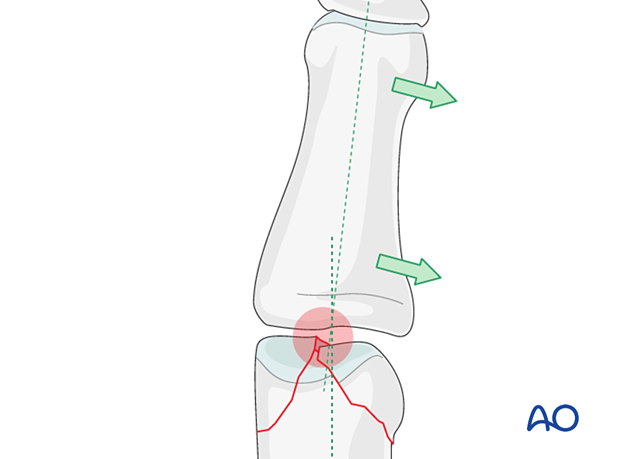
2. Patient preparation
Place the patient supine with the arm on a radiolucent hand table.

3. Approaches
For this procedure, the following approaches may be used:
4. Reduction
Visualization of the fracture
Use a dental pick to gently explore the fracture site to assess its geometry. The pick can also be used carefully to reduce small fragments. Take great care to avoid comminution of any fragment.
It is important to maintain the vascularity of tiny fragments attached to the collateral ligament, to avoid osteonecrosis.
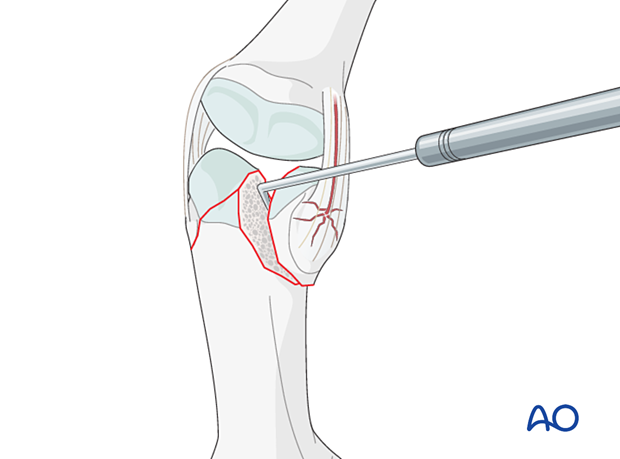
Indirect reduction
Reduction starts with traction to restore length.
Exert lateral pressure with your thumb and index finger or with dedicated percutaneous reduction forceps to reduce the fracture.
Confirm reduction with an image intensifier.
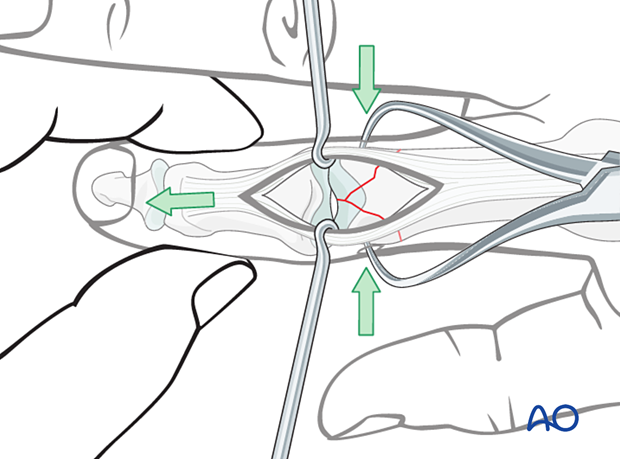
5. Fixation of small fragments
Screw positioning in small fragments
If only one screw can be inserted into each small fragment, they will have to be placed within the joint cavity but through the nonarticular face of the condyles, distal to the collateral ligament.
Insert lag screws according to the standard manner.
The screw tracks should be planned in different planes to avoid crossing each other.
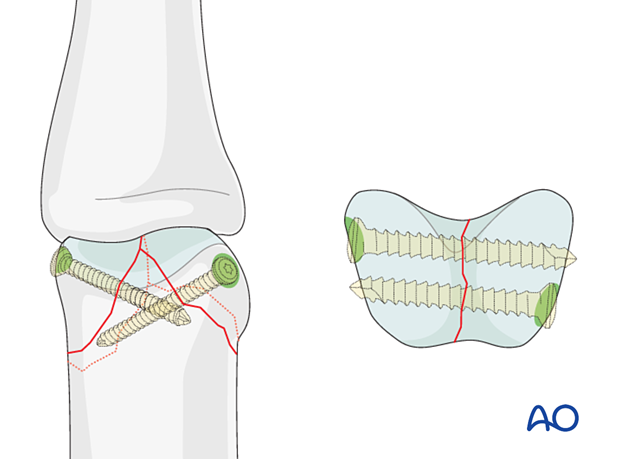
If the screw insertion comes to lay in or close to the articular surface, the screw head should be subchondral or else the use of a headless screw should be considered.

The lateral aspect of the phalangeal head, which is safe for screw placement, can be approached by flexing the proximal interphalangeal (PIP) joint.
The use of a headless cannulated screw is recommended to avoid ligament irritation due to a protruding screw head and eventual joint stiffness.
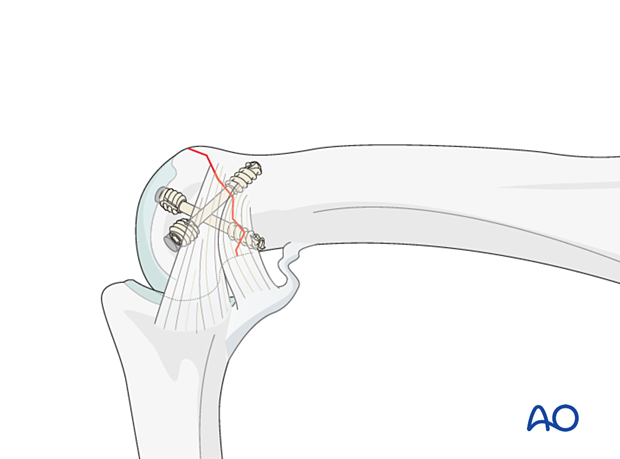
Determining screw size
Screw length needs to be adequate for the screw just to penetrate the opposite cortex.
Keep in mind that at the apex of the fragment, the minimal distance between the screw head and the fracture line must be at least equal to the diameter of the screw head. If necessary, a screw of smaller diameter will have to be chosen.
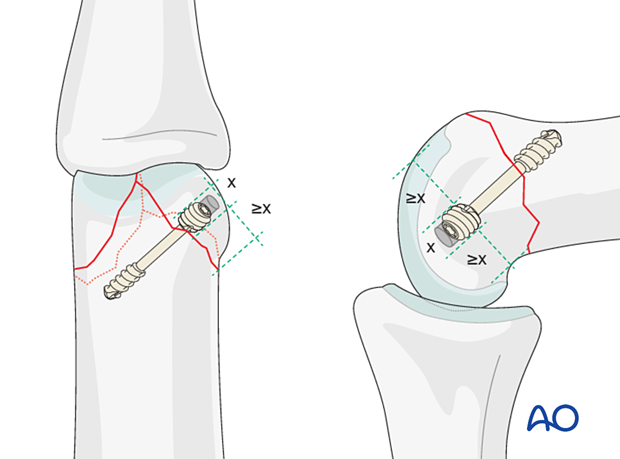
Screw insertion
Sparing the ligamentsMost of the fracture line on the lateral aspect of the head is covered by the collateral ligament.
Flexing the PIP joint will draw back the collateral ligament, which can be further retracted with a hook to expose the intraarticular lateral aspects of the condyles.

On the lateral extraarticular aspects of the condyles, there is a small ridge on each side. These are uniquely suited for screw placement, as the screws can be buried deep to the edge of the cartilage without violating the joint surface and avoiding causing irritation.
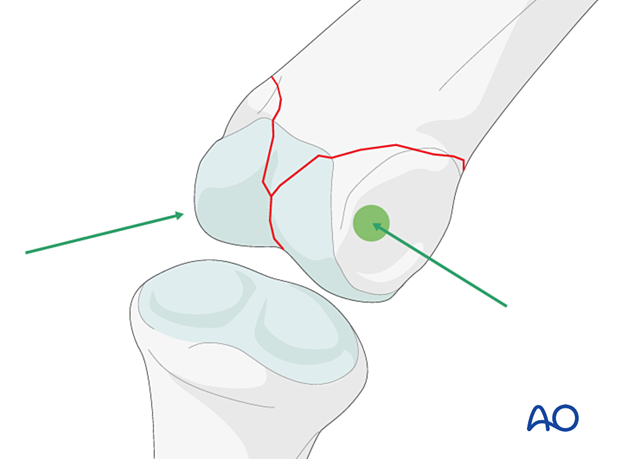
Before the first screw, insert both guide wires.
Confirm anatomical reduction of the articular surface and stability.
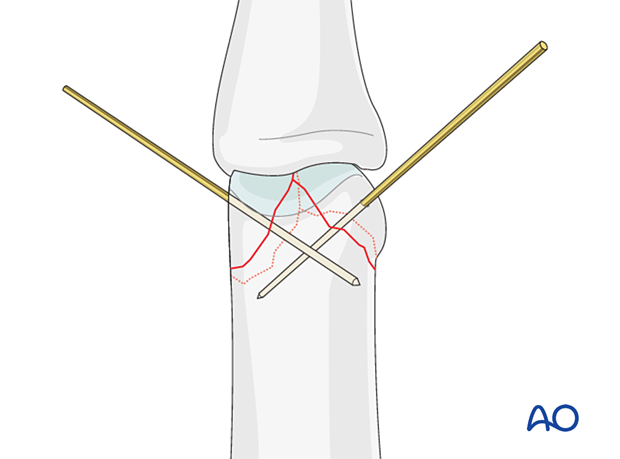
Insert the headless screws and gently tighten them to compress the fracture.
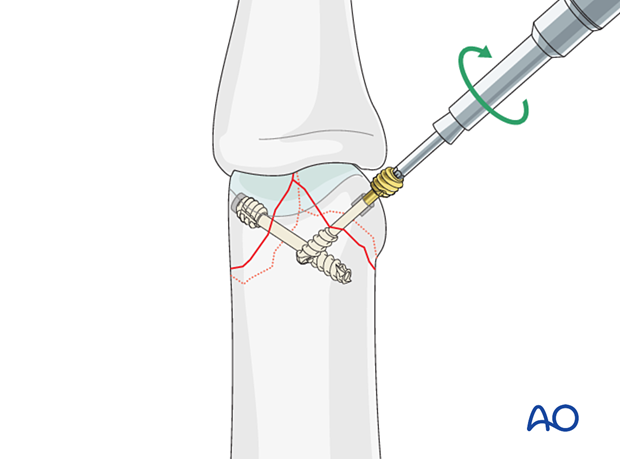
6. Fracture fixation with large fragments
Screw positioning
In a fracture with large fragments, some screws can be placed safely proximal to the collateral ligament.

Preliminary fixation
To avoid rotation of fragments during drilling and screw insertion, temporarily insert K-wires to stabilize the fragments.
Be careful to place the K-wires so they will not conflict with later screw placement.
Avoid inserting a K-wire into a small fragment, as it is in danger of fragmentation.
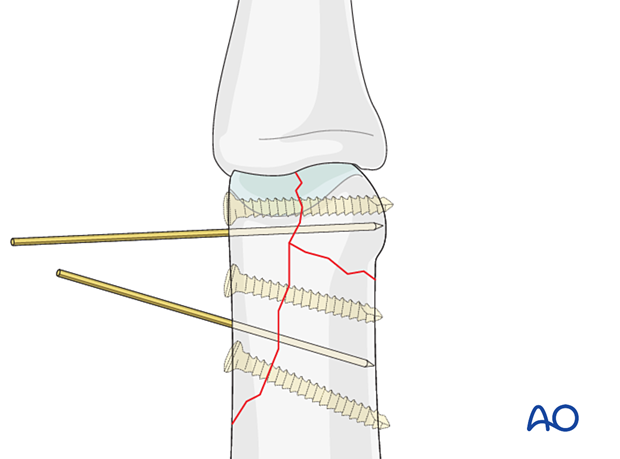
Screw size selection
The exact size of the diameter of the screws used will be determined by the fragment size and the fracture configuration.
The various gliding and thread hole drill sizes for different screws are illustrated here.

Pitfall: countersinking

Screw length pitfalls
- Too short screws do not have enough threads to engage the cortex properly. This problem increases when self-tapping screws are used due to the geometry of their tip.
- Too long screws endanger the soft tissues, especially tendons and neurovascular structures. With self-tapping screws, the cutting flutes are especially dangerous, and great care has to be taken that the flutes do not protrude beyond the cortical surface.

Pitfall: screw too close to the fracture
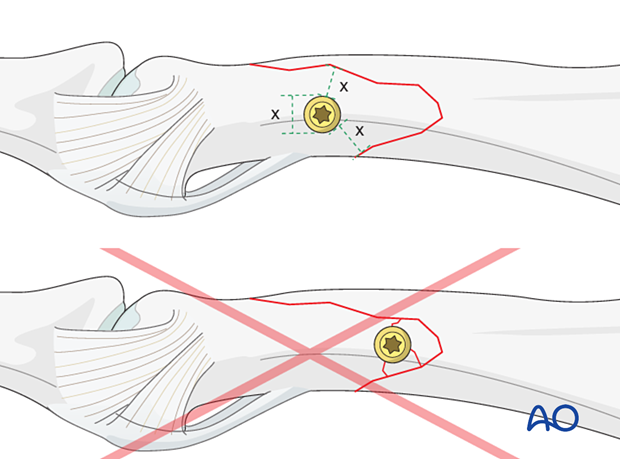
Pitfall: beware of fissure lines
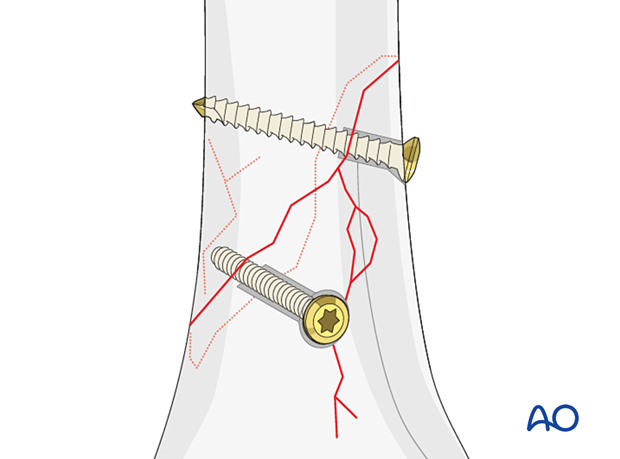
Screw insertion
Insert the distal screw first to fix the articular block.
Insert further lag screws to fix the metadiaphyseal fracture.
Confirm anatomical reduction and correct screw placement with an image intensifier.
Check stability of the fixation by passive flexion and extension of the PIP joint, and by applying gentle lateral and rotational motion. This will help to determine stability to establish strategies for rehabilitation.

7. Final assessment
Confirm anatomical reduction of the articular surface and correct screw placement with an image intensifier.
8. Aftercare
Postoperative phases
The aftercare can be divided into four phases of healing:
- Inflammatory phase (week 1–3)
- Early repair phase (week 4–6)
- Late repair and early tissue remodeling phase (week 7–12)
- Remodeling and reintegration phase (week 13 onwards)
Full details on each phase can be found here.
Postoperative treatment
If there is swelling, the hand is supported with a dorsal splint for a week. This would allow for finger movement and help with pain and edema control. The arm should be actively elevated to help reduce the swelling.
The hand should be splinted in an intrinsic plus (Edinburgh) position:
- Neutral wrist position or up to 15° extension
- MCP joint in 90° flexion
- PIP joint in extension
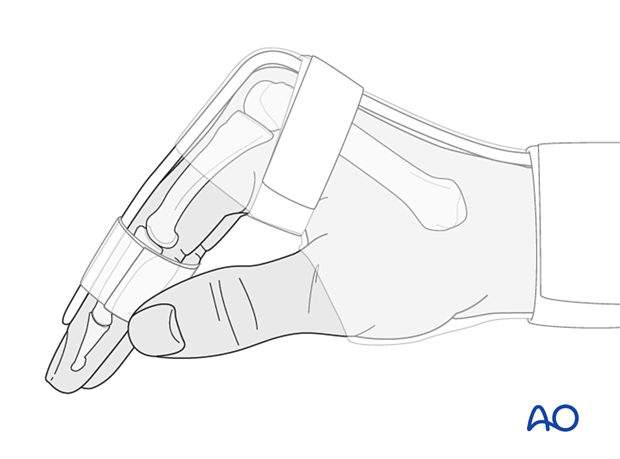
The reason for splinting the MCP joint in flexion is to maintain its collateral ligament at maximal length, avoiding scar contraction.
PIP joint extension in this position also maintains the length of the volar plate.
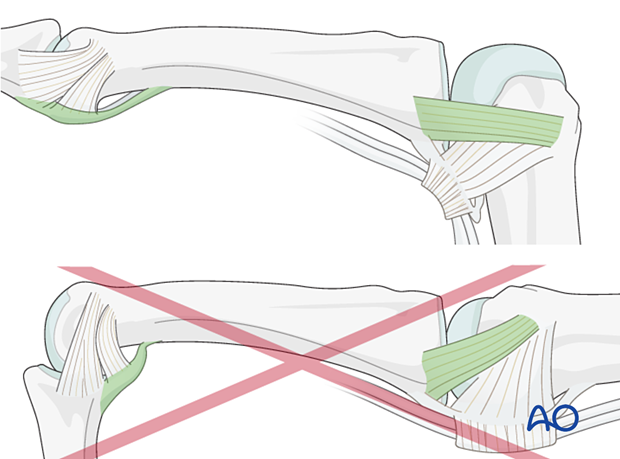
After subsided swelling, protect the digit with buddy strapping to a neighboring finger to neutralize lateral forces on the finger.
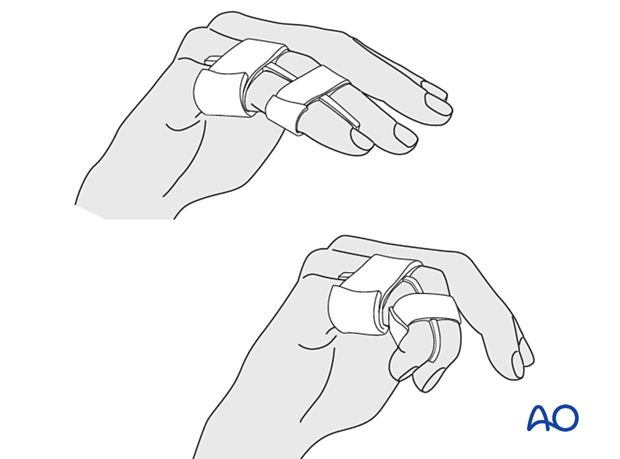
Functional exercises
To prevent joint stiffness, the patient should be instructed to begin active motion (flexion and extension) immediately after surgery.
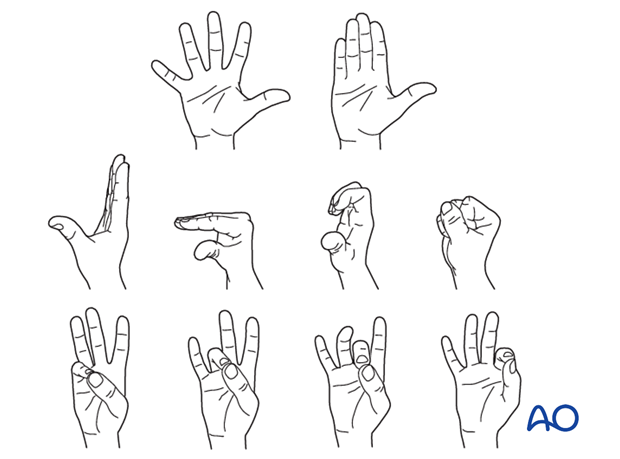
Follow-up
See the patient after 5 and 10 days of surgery.
Implant removal
The implants may need to be removed in cases of soft-tissue irritation.
In case of joint stiffness or tendon adhesion restricting finger movement, arthrolysis or tenolysis may become necessary. In these circumstances, the implants can be removed at the same time.













